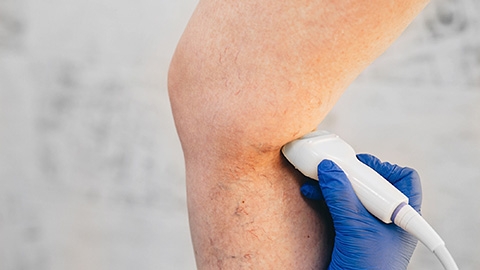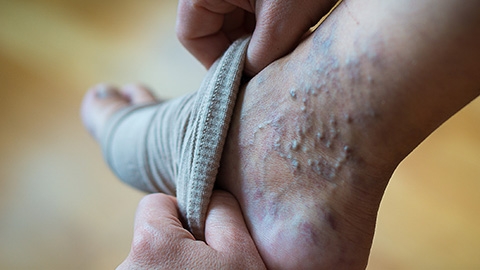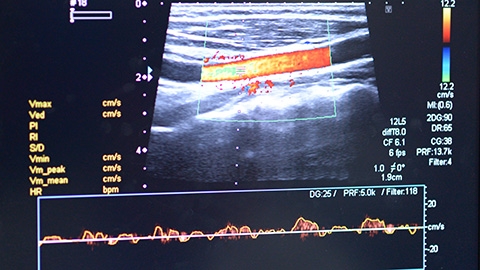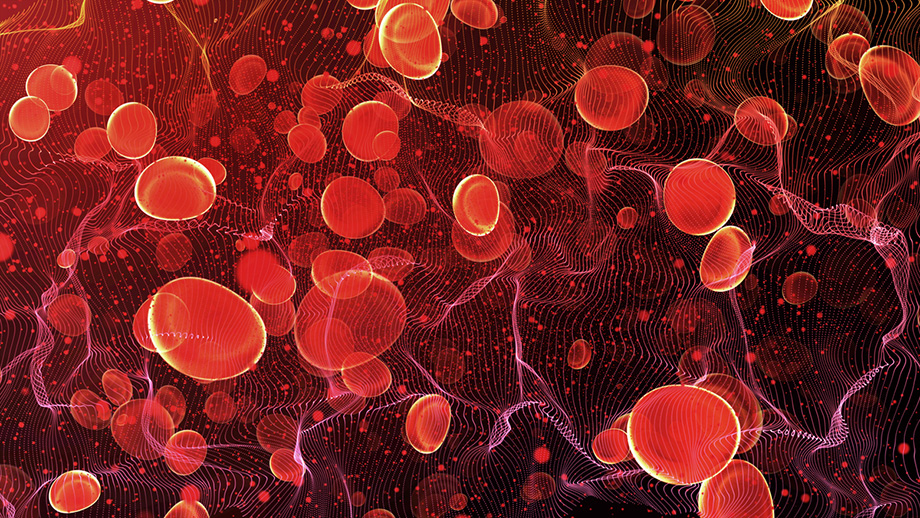Reviewed June 2023 to maintain the latest information in treatment and research.
An interview with Danielle Bajakian, MD, vascular surgeon and Director of the Columbia Vein Program.
What’s new in vein treatment?
Vein treatment has changed dramatically since I did my residency a long, long time ago. The majority of treatments that I offer for venous patients are office-based procedures that do not require an operating room, they don't require anything other than local anesthesia, and most of them don't even require an incision.
Because this is a hereditary disease, for the most part, a lot of patients delay their treatment because their mom or their grandmother had a procedure done that required a prolonged hospital stay or had a lot of pain afterwards, and they remember those things and so they're reluctant to come into the office. But the majority of the time, I can treat them with laser therapy, radio frequency therapy, or sclerotherapy. All of these are catheter-based procedures to eliminate veins that are causing problems. There are also some newer options that include using a glue to seal closed the vein.
Wow, it’s great to hear the majority of care doesn’t need an incision. What about the treatments that still do require surgery? Have those changed at all?
Yes, that's a great question. Some of the therapies for vein disease—the tried-and-true methods that have been around for 20, 30 years—are still being used. Specifically, treatment for varicose veins or the large ropy veins that you see in the lower leg—those are really best treated with removal, instead of say, laser therapy.
So, the removal method is still very similar, however, some of the techniques have changed. It used to be that we would use pretty large incisions to remove these varicose veins. Nowadays, I do this through a very small incision, and I use an instrument, it's almost like a crochet hook, to remove these veins. So cosmetically, it's significantly more appealing, and again, I offer it in the office instead of the operating room.
In terms of treatment technology, is there any new tech that people should know about, or new devices you’re using/will use in the future?
Treating the veins higher up in the pelvis does require an operating room or a procedure room. And one of the things that we found more recently is that patients who have lower extremity vein problems also have venous compression, called May-Thurner Syndrome, a very common anatomic problem. Venous compression of an overlying artery can have the same type of symptoms as lower extremity venous issues. And the best way to treat that currently is with a stenting procedure. This is done in a procedure room with wires and catheters.
In the narrowing of the vein, we place a stent that is designed to keep the vein propped open, where the artery is overlying it. And there are significant advances in the stent technology over the past several years. That's really been one of the more exciting new technologies that have been developed.
In addition to that, some of the office therapies that we're using to treat lower-extremity venous issues is a technology to occlude the veins. And for the last maybe 15 or 20 years, we've been predominantly using heat technology, meaning radiofrequency or laser therapy, to heat the inside walls of the vein and seal the vein closed. For the majority of my patients, that's still what I offer, because I think it's great. It’s a really effective technology, with good long-term data.
However, we're always looking for some new means of sealing closed these veins for the benefit of patient comfort. Because the only downside of the therapy that we offer in the office now is that some patients are a little bit uncomfortable. Maybe they don't like needles or needing that type of anesthesia. So the new glue technology to seal closed the vein really requires minimal anesthesia. Just one needle to give a little bit of local anesthesia for a catheter insertion, and then after that, the patients don't feel a thing.
Then there are injection therapies or sclerotherapy, utilizing a foam or almost a liquid to seal closed the vein. And while in the past that has not been quite as successful as the things that I previously described, we're starting to look for new technologies and new techniques to improve the efficacy of that.
How long do these procedures take? How long to seal closed a vein?
The procedure itself takes about 20 minutes in the office.

Walk us through that process.
Well, to start, the majority of my patients do this awake. And I have had this procedure done myself, awake. So when I speak to my patients, I really speak about my own personal experience, too. But for my very nervous patients I offer them a valium tablet that they take in the office.
Under ultrasound guidance in a sterile procedure room, the vein is accessed usually in about the mid-calf level, with a small incision. Just large enough to put a catheter in place basically, almost like a piece of intravenous tubing. And that's positioned under ultrasound guidance into the proper vein, and then numbing medicine or tumescent anesthesia is typically given along the vein.
And then the sealing closed of the vein really doesn't hurt at all. The catheter is inside the vein where obviously there are no nerve fibers. So, whatever technology is chosen to seal closed the vein, that takes the minority of the time, probably about five minutes. And then all the catheters are removed, patients have a bandaid on their leg, and they're able to walk out and go back to work, back to their lives, even exercise the same day.
It seems pretty straightforward, so why do so many of these vein diseases and disorders go undiagnosed?
Sometimes people just don’t know they have it. Other times, people who know they have venous disease either feel like it may not be a significant problem or have been told it’s not significant unless it’s causing bleeding or ulcerations.
Even while it causes a poor quality of life, patients are reluctant to seek treatment. It’s put on the back burner because they have more important things to do. So, knowing that you can have procedures done in 20 minutes and really only need to block off time for a few office visits makes it a lot more appealing, and their quality of life afterward is significantly improved.
Let’s talk about symptoms and prevention. What should we be looking out for?
That's a great question and I'm going to answer it in a couple of parts.
For some patients, it's obvious, and the things to look for are big ropy veins in the legs. These varicose veins that we spoke about, leg swelling, ankle swelling—if it’s worse at the end of the day. Dark pigmentation and a lot of spider veins around the ankles are easy ways to figure out if you have venous disease.
However, some more subtle symptoms are leg heaviness, leg fatigue. It's typically worse at the end of the day or after you've been standing for a long period of time. Sometimes combined with a little bit of ankle swelling. Restless legs at night can be an early diagnosis of that type of problem. Some people also develop itchy dry skin around their ankles. These are all vague signs and symptoms that often get ignored.
Think about people who stand for long shifts without moving around a lot. Physicians, medical workers, pharmacists, retail workers, cashiers, chefs. That’s who tends to get these symptoms, and they often ignore them thinking they’ve just worked a long day and heavy legs are normal.
What are the most common vein problems folks get from this type of work?
The majority of the time it’s superficial venous insufficiency, and I describe it as leaky valves in the veins. Since the veins are what bring the blood from the feet back up to the heart, they have to work against gravity, and so your calf muscles pump the blood up these one-way valves that are supposed to close so that the blood doesn't go back down again. And when your valves are leaky there’s a lot of increased pressure, especially standing when the veins have to work against gravity. That pressure is one of the things that causes the heavy, achy, tired legs.
And then with all the increased pressure, fluid starts seeping out and people get ankle swelling. Sometimes in the more severe form, these tiny branches of the vein that have the increased pressure start serving as outflow valves, and that's where the varicose veins come from.
Are there ways to prevent these types of issues when standing on your feet all day, exercises that would be helpful?
For good vein health, I always tell my patients to continue with exercise. And that doesn't have to be anything complicated. Walking a couple of times a day is really helpful. Increased calf muscle pumping like walking, exercising, all of that, assists your veins to bring the blood from the feet back up to your heart.
Trying not to stand or sit too much without moving around is really helpful. And then the other things are a little bit more obvious, and that's elevating your legs at the end of the day because that basically assists gravity in helping to drain all that fluid from your legs. It gives a lot of symptom relief.
Lastly, compression stockings! The ones they make today are not the ugly ones our grandparents used to wear. They’re more breathable, easier to wear, better fabrics and technology.

There are ads for vein centers all over the city. What is the benefit of seeing a surgeon for these procedures instead of going to one of those centers?
The benefit of seeing a surgeon like myself is that we address a thorough variety of vein problems. It’s a common misconception that once you treat a vein, you're done for life. Vein disease is an ongoing chronic pathology. And I end up seeing a lot of my patients for years and years because it can be a progressive disease. It's not, for example, like fixing a hernia where once it's fixed, you don't need to see your surgeon anymore.
For most patients, the real goal in treatment is to alleviate their symptoms. So, the first issue is to figure out if their leg pain is related to their underlying vein problem. If there's more than one issue going on and I treat the vein pathology, they may still have this leg pain and that's obviously an unsatisfactory result.
So, number one, coming to an academic medical institution where I have the opportunity to do a full workup and really assess if there are other underlying pathologies for the leg pain. Many of my patients who specifically come in to have their veins treated, I diagnose with spinal problems, neurologic problems, sometimes even arterial problems. That’s an important distinction between seeing someone who just advertises that they are a vein specialist and coming to an academic institution and being evaluated by a vascular surgeon.
And number two, we’re looking at the entire venous system, the deep venous system, the superficial venous system, the varicose veins, what's on the skin…all of these sometimes require treatment. And we offer all of those different therapies, starting from treating blood clots or putting in iliac stents if needed, to doing the venous ablations that we discussed, to the flavectomies, and then finally the sclerotherapy for spider veins. I can come up with a comprehensive plan for the patients who need it.
Also, in the most severe form of this problem, patients can even have venous ulcers, and that requires a significant amount of attention to heal. So, in addition to offering all of these therapies, patients often require aggressive wound care, which we do in our vascular surgery office.
What’s new in research for vein diseases?
You know, in the five-to-ten-year pipeline, I mentioned earlier that the majority of these problems are related to problems in the underlying valves in our veins. I think removing or sealing veins are great technologies that we will further enhance, but the idea behind the technology will stay the same.
There are veins that have this valve problem that we can't remove because they're vital to us, our deep vein system. And when the valves and those veins don't work properly, we don't have good technology to treat that. And currently, the mainstay is managing the leg swelling and the symptoms. But it doesn't cure the problem, it merely assists in making patients feel better. However, a lot of studies are being done to see if we can find an artificial valve that might work to take over this type of problem. I’m very hopeful.
That’s great to hear. What excites you the most about the future of care?
Although most of the time, this is not a life-threatening problem—I call it a “lifestyle problem”—the fact that I'm able to offer so many technologies that give people back their mobility, comfort, ability to exercise, etc. I'm pretty thrilled, and we’ll keep making them better. It’s not just compression stockings anymore, even though compression therapy is very important. Or even in more severe forms with lymphedema pumps, being able to treat this deep venous disease is really going to change things for our patients who we don't have anything but symptom management to offer.

Is lymphedema treated in the same way as venous disease? They’re different issues, right?
Yes, that's exactly right. Lymphedema is a different problem than venous disease. The therapies are sometimes similar, because really what we're doing is we're managing the swelling. And this requires compression therapy and there are various forms of doing that.
Compression stockings is certainly one of them, but there are lymphedema pumps, lymphatic massage, etc. I'm finding that many of my patients with lymphedema also have venous insufficiency. And by treating the underlying vein problem, I certainly don't cure them, but oftentimes, I give them a little bit of relief in the heavy, achy, tired feeling that they get.
And that makes it easier to be more compliant with the compression therapy. So, for patients who come into my office with lymphedema, although we don't have a good treatment currently for it, I do pursue additional studies looking for underlying vein problems and by treating those, I can give them some relief.
Let’s talk deep vein thrombosis. What’s new in treatment?
The majority of the more acute and life-threatening vein problems I treat is DVT, deep vein thrombosis. This is a problem where there's an acute blood clot in the veins, either in the leg or in the pelvis, and the biggest life-threatening issue with this type of problem is not the leg swelling or the leg pain that develops, but if a piece of that breaks off and travels to the lung, it's called a pulmonary embolism, that can result in severe cardiac, pulmonary issues and even death. And so early diagnosis and early treatment are really vital.
A rapid ultrasound either in the office or the emergency room can be lifesaving. And especially in young, healthy patients, it's very easy to say oh, well, I went to the gym, I pulled muscle and maybe it'll get better. Those are the patients who I find come into my office really late and have a surprising diagnosis and a more extensive blood clot.
Are you removing these blood clots after diagnosis or using other therapies?
The first therapy once we diagnose the problem is blood thinners, that’s the lifesaving therapy. Often done with pills. But depending on where these blood clots are, sometimes I recommend removing a blood clot to prevent further problems, to decrease the leg swelling, to prevent the long-term bad consequences of having a blood clot in the leg (chronic leg swelling, chronic ulcers, things like that).
To remove it we use a medication to break up the blood clot and use wires and catheters to suck the blood clot out. This can be done in a single setting in the operating room. And if I find a reason for the blood clot, I treat it with a stent to prevent further blood clots.
Does deep vein thrombosis fall under the category of “lifestyle problem” or do other medical conditions, predispositions contribute to this?
There are really a lot of risk factors for getting blood clots, so a bit of both. Could be from not moving around for long periods of time, bed-bound or sedentary, after an injury or recovering from surgery. Even long plane flights.
With hereditary syndromes that can cause this, sometimes patients don't realize they have the problem until they've had the diagnosis of a blood clot. That’s when we look further into whether or not they need long-term therapy or a genetic workup and go through family history and diagnose it that way.
Medical problems can certainly cause this as well, patients who have cancer are more likely to be in a situation where they can develop blood clots. During the pandemic, patients with Covid-19, the majority of them are hypercoagulable, and there was a real significant increase in deep vein thrombosis in this population.
So, it's important to recognize leg pain, leg swelling, sometimes in conjunction with chest pain. It's really an urgent situation where you need to seek medical care immediately.
Other than being as active as you can, is there anything else people can do to prevent blood clots?
In any situation when you’re at high risk for a blood clot, even a long plane flight, there are a few important things to do. Most important is staying hydrated. And staying active, even if you’re doing calf exercises while sitting down. Get up, walk around.
Let’s talk insurance. With vein procedures, newer technology, even cosmetic treatments, what’s usually covered?
That's a great question. If patients have symptoms from vein disease, the procedures should be authorized by insurance. And I am a real advocate in working with my patient’s insurance companies to get these procedures covered.
There is some variability. A few of the more experimental or newer procedures are not covered by particular insurances. But I feel really strongly that if patients are symptomatic, and they have an underlying problem, we come up with a treatment plan that will be covered by their insurance so they do not need to pay out of pocket.
What are your goals over the next five to 10 years?
I want to keep offering my patients the newest technologies, which I am so privileged to be able to do at an institution like Columbia. Here, we’re able to offer therapies in clinical trials, participate in the research. It’s not just the most advanced therapies already on the market, but I’m also involved in studying newer and newer technologies. And I plan to continue that work over the next decade.
I feel so privileged to be able to care for this community in Washington Heights, in New York City, all my patients who come from other states and countries. And I want to do more outreach to our local community. I want people to know that I will do everything I can to work with them and their insurance providers to create a treatment plan that works for them.

